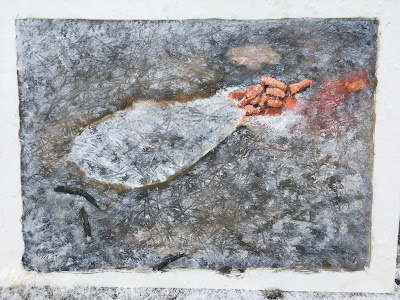 |
Her en hurtig efterskitse af dagens tomt- og Pulkenkryss. |
Ja jeg troede jo, at jeg skulle male
videre på mit maleri af engvegetationen i januar, men så sneede det
hele dagen i går, og i dag er det skiføre. Jeg går jævnligt ud på
terrassen og kigger ud over Pulken. Der kunne jo være noget, og i
formiddags bemærkede jeg, at der var en flok sjaggere nede og pille
i jorden ved Pulkens centrale kær. Størstedelen af vandfladerne er
tilfrosne, men i kanten mellem den snedækkede eng og det tilfrosne
kær er der en bræmme mudder, som ikke er helt frossen. Det var den
sjaggerne var interesserede i. Jeg smuttede ind efter teleskopet.
Da jeg kom ud igen var sjaggerne væk.
Der var stære, ca 50. Og jo, også en sjagger. Eller hvad, næ! Det
var en misteldrossel, som nu hoppede rundt i mudderkanten. Det er mit
første vinterfund i Pulken. Det er fjortende år jeg kigger på
fugle her, så det var ikke en hverdagsobservation.
Frostvejr ændrer betingelserne for
fuglene. En mængde fødekilder lukker ned og fuglene koncentreres
omkring de steder, hvor føde endnu er tilgængelig. Det var helt
tydeligt, at kæret i Pulken i dag var et sådant sted. Jeg gik
derfor ud for at se, om der var mere at støve op. Fra p-pladsen
kiggede jeg ud mod kæret, der lå en enlig sangsvane. Og så kom en
piber spadserende hen over isen.
Jeg kunne se med det samme, at nu var
den gal igen. Selvom afstanden var ganske stor, var det tydeligvis
ingen engpiber. Bortset fra at overgumpen var rødbrun, og ikke grå,
mindede den med sin næsten ustribede, rødbruntonede ryg og sin mere
gråtonede isse lidt om en sjagger. Ingen gyldne toner i dragten.
Bryst og bug nærmest samme snavset hvide farve som bryozokalk, men
undergumpen skinnende hvid. Og så øjenbrynsstribe og et enormt næb
med orangeagtig basis. Pulkens første bjergpiber, og dertil et meget
sjældent indlandsfund (faktisk muligvis det første) i Kristianstads
Kommune, hvor arten iøvrigt nu ikke længere er årligt
forekommende. Det er min Pulken-art nr 196. Den forsvandt desværre
for mig, mens jeg fotograferede den, men resten af dagen holdt jeg
jævnligt øje med kæret.
Kl. 13:40 var den fremme igen – denne
gang som matrikelart nr. 177! Jeg ringede til et par venner, og
sammen gik vi en lang runde i Pulken, desværre uden at genfinde
fuglen. Dog rastede 11 pibere inde i rørene – en blå kærhøg fik
dem på vingerne, men desværre uden kald. Trampeturen gav til
gengæld tre dobbeltbekkasiner. Og pænt var her- med snedække, som
efterhånden heller ikke er helt almindeligt.
Her et par doku-fotos. Ærgreligt, at jeg rystede på hænderne, det øverste foto havde blevet udmærket MED hoved, men man kan da se hvad det forestiller:

















